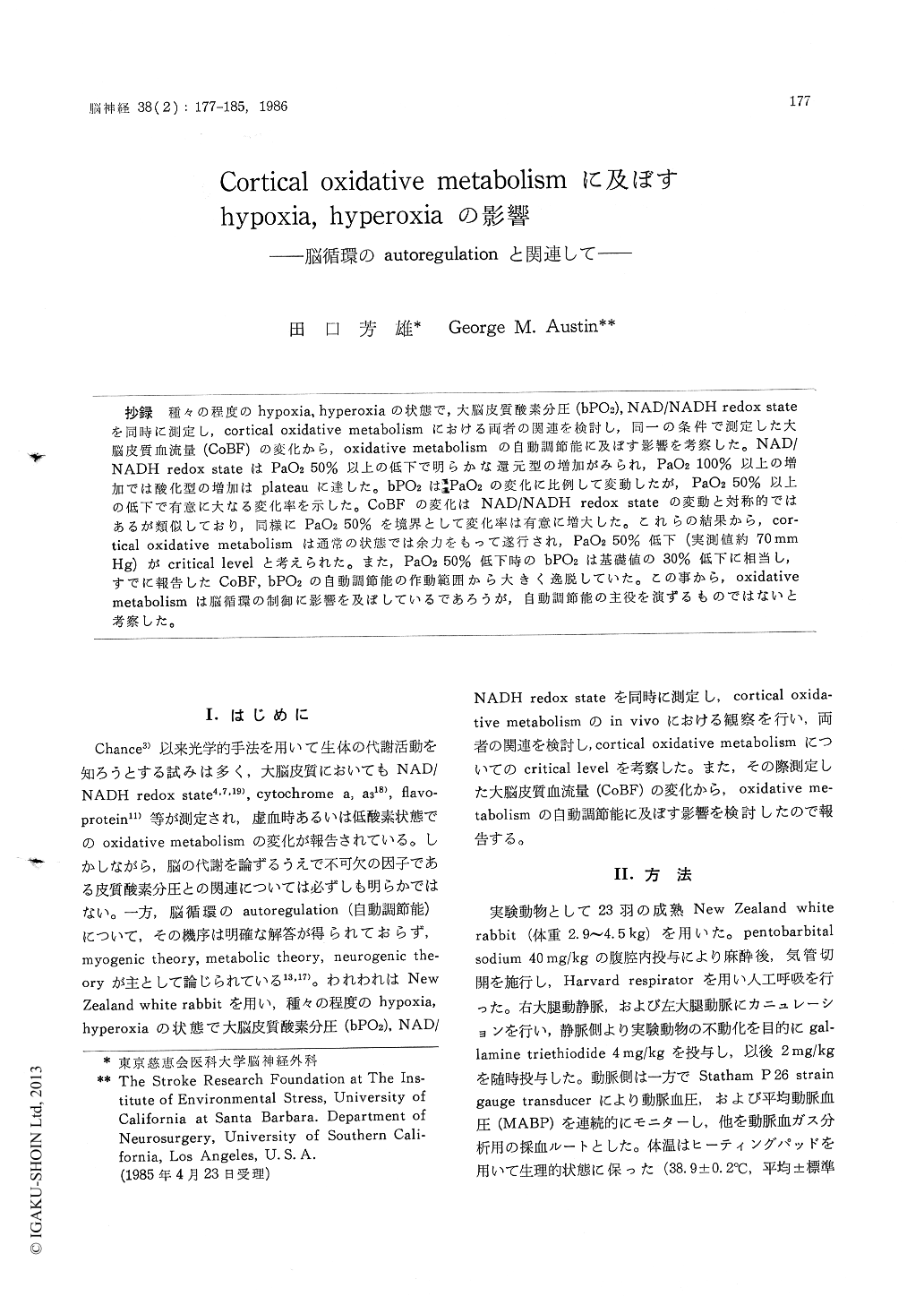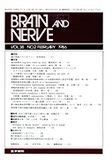Japanese
English
- 有料閲覧
- Abstract 文献概要
- 1ページ目 Look Inside
抄録 種々の程度のhypoxia,hyperoxiaの状態で,大脳皮質酸素分圧(bPO2),NADINADH redox stateを同時に測定し,cortical oxidative metabolismにおける両者の関連を検討し,同一の条件で測定した大脳皮質血流量(CoBF)の変化から,oxidative metabolismの自動調節能に及ぼす影響を考察した。NAD/NADH redox stateはPaO2 50%以上の低下で明らかな還元型の増加がみられ,PaO2 100%以上の増加では酸化型の増加はplateauに達した。bPO2はPaO2の変化に比例して変動したが,PaO2 50%以上の低下で有意に大なる変化率を示した。CoBFの変化はNAD/NADH redox stateの変動と対称的ではあるが類似しており,同様にPaO2 50%を境界として変化率は有意に増大した。これらの結果から,cor-tical oxidative metabolismは通常の状態では余力をもって遂行され,PaO2 50%低下(実測値約70mmHg)がcritical levelと考えられた。また,PaO2 50%低下時のbPO2は基礎値の30%低下に相当し,すでに報告したCoBF,bPO2の自動調節能の作動範囲から大きく逸脱していた。この事から,oxidativemetabolismは脳循環の制御に影響を及ぼしているであろうが,自動調節能の主役を演ずるものではないと考察した。
Our earlier studies have shown that local cor-tical blood flow (CoBF) in the rabbit has been autoregulated in a narrow range of mean arterial blood pressure (MABP) and autoregulation of cor-tical oxygen tension (bPO2) has been maintained in a wider range (75-110 mmHg) than that of CoBF. In the present studies, bPO2, NAD/NADH redox state, and CoBF were measured under the various conditions of hypoxia and hyperoxia to discuss the critical level of cortical oxidative me-tabolism and autoregulation of CoBF in relation to oxidative metabolism.
New Zealand white rabbits were anesthetized with pentobarbital sodium intraperitoneally and paralyzed with gallamine triethiodide intrave-nously. They were ventilated artificially maintain-ing normal blood gas analysis. NAD/NADH re-dox state was measured with a compensated fluo-rometer with a reflectance device to correct for hemodynamic artefacts and bPO2 was monitored continuously with the polarographical method. They were measured simultaneously. CoBF was monitored with the thermal diffusion cerebral blood flow monitor of Flowtronics. Hypoxia and hyperoxia were produced by decreasing or increa-sing the inspired oxygen concentration. Arterial blood samples were obtained for blood gas deter-mination before and during the episode of hypo-xia or hyperoxia.
A definite reduction of NADH began at a 50% decrease of PaO2. It corresponded to 70 mmHg of Pa02. Below 50% decrease of Pa02, NADH was reduced largely. This was statistically significant (p<0.01). Although, the oxidation of NADH occurred in the moderate hyperoxic state, no oxidation of NADH occurred more than 6.1% of full scale even in the condition of higher PaO2. This seemed that non-oxidative metabolism might take a part in normal cerebral metabolism. On the other hand, bPO2 changed linearly along with the changes of PaO2. The statistical analysis, however, disclosed that the changing rate in the range below 50% decrease of PaO2 was significantly larger than that in the range between 50% decrease and 100% increase of PaO2 (p <0.01). These results suggested that bPO2 was insufficient for cortical oxidative metabolism in the range below 50% decrease of PaO2. We advocated that 50% decrease of PaO2 (70 mm Hg of PaO2) was the critical level of corticaloxidative metabolism.
CoBF decreased in the hyperoxic state and in-creased in the hypoxic state. The changing rate of CoBF in the range below 50% decrease of PaO2 was significantly large (p<0.05). This suggested that the changes of CoBF were closely related to oxidative metabolism in the hypoxic state. The value of bPO2 that a definite reduction of NADH and a significantly large increase of CoBF began was a 30% decrease from initial value. This cor-responded to the value of MABP 65 mmHg when autoregulation of bPO2 was tested. At this MABP, both CoBF and bPO2 were no longer autoregula-ted. We therefore conclude that the metabolic control for cerebral blood flow may play a role in the ischemic or severe hypoxic state, but it should be denied as a main factor of cerebral blood flow autoregulation.

Copyright © 1986, Igaku-Shoin Ltd. All rights reserved.


